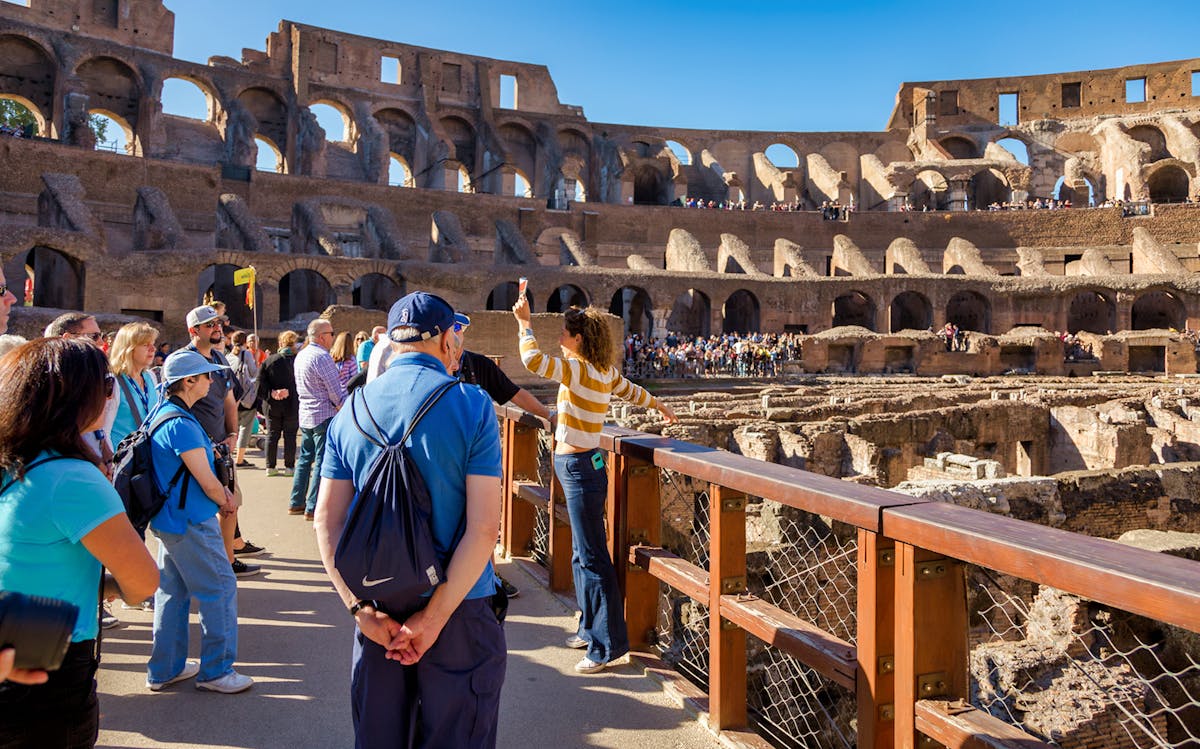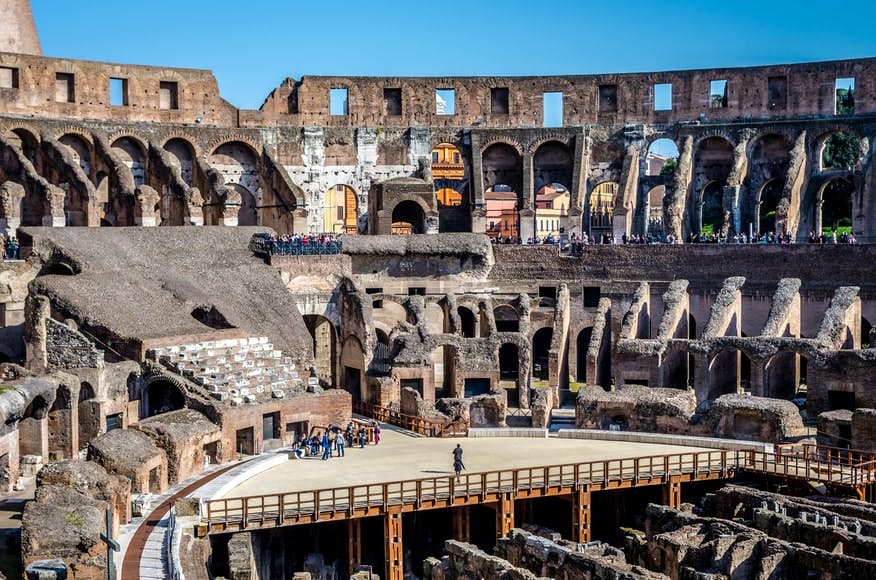The Roman Colosseum, the largest ancient amphitheater still standing today, was named one of the New 7 Wonders of the World in 2000. It’s more than just an architectural marvel—it was once the dramatic stage for intense gladiatorial combat and, at times, even mock naval battles. Imagine 80,000 roaring spectators packed into the massive arena, cheering on these gladiators—many of whom were enslaved people, criminals, or prisoners of war—fighting for their freedom and survival. The thrill and horror of those bloodthirsty crowds leave us to wonder: what did "entertainment" really mean to the ancient Romans?
But there’s more to the Colosseum than just these battles. Join me as I dive deep into the captivating history of the Colosseum Arena and unravel all the fascinating details, so you can decide for yourself if it’s truly worth all the hype. For the record...it is!
What Is The Colosseum Arena?

The Colosseum was originally a Flavian amphitheater built to stage combat. Previously, on the site of the Colosseum stood a private lake built by Emperor Nero. His successor, Emperor Vespasian drowned the lake and built the mighty Colosseum on the site as a gift to the Rom"an people.
The Colosseum Arena, where gladiators once fought these fierce and fabled battles, had a wooden floor covered with sand—designed to soak up all the blood from the brutal clashes. Around 2,000 years ago, up to 80,000 spectators would gather to watch these life-or-death contests. Most often, gladiators fought each other, but occasionally, they faced off against wild beasts like tigers and lions. It was the original “man versus wild,” with emperors, senators, and intellectuals in the crowd, all eagerly watching the action unfold. The atmosphere must have been electric, if not chilling.
Recommended Colosseum Arena Tickets
If you are looking to learn more about the Colosseum Arena, you’re in luck. There are Colosseum tickets that give you a deep insight into the making and the remains of the Arena, the hypogeum, and the gladiators’ backstage entrances. You will also be able to use the same entrance used by the gladiators for this tour, which is not accessible by those with general tickets.
Other Colosseum Tickets & Tours
Are Skip-the-Line Colosseum Tickets Really Worth The Money?
What Was The Colosseum Arena Used For?

The Colosseum Arena served as a wildcard to freedom for gladiators. It provided them with hope for freedom, should they become the best gladiator on the floor. They fought each other till death and sometimes to wild animals that were caged below the Arena. The battle floor is connected to the Ludi, a school where the best gladiators were taught to fight. Only one such Ludus called Ludus Magnus stands today which is located close to the Colosseum and can be accessed with a tour of its own.
It is believed that the gladiator games started as a funeral ritual of the Nobel. The games were heavily funded by the wealthy and powerful to entertain the common man and gain their support at the cost of the gladiator souls. On its opening in 80 AD, Emperor Titus himself funded one hundred straight days of games. This brutal practice was put to an end by Constantine in 325 CE since he believed in civil and domestic peace.
Under The Colosseum Arena
Arena in Etruscan, the language of ancient people of Etruria, means Sand. It is named after the sand on which the gladiators fought. Although I could not see the surface of the sand, I could see the levels beneath it. The underground passageways are covered with a wooden floor called hypogeum, which is absent now. The walls of the underground make up the two-storey labyrinth. It connects the rooms of the gladiators, the chambers of exotic animals to the main floor stage. Complex machines were used to move the animals to the Arena floor from the cages and the manual work was done by the slaves and prisoners of war.
Natural disasters, in particular, a series of earthquakes from the 5th century to the 14th century are to be blamed for the destruction of the Colosseum. The best way to experience the remains of it is by taking a Colosseum Underground Tour where a local guide gives you tea about its best-kept secrets.
Things To See In The Colosseum
Along with the Arena, there’s plenty more to explore at the Colosseum. Here are some sections that must be taken notice of on your tour.

The exteriors of the Colosseum are just as mesmerizing as their interiors. It measures 186 meters in height and 156 meters wide. Travertine limestone, marble, and concrete were used in the construction to lend it the imposing look we can see today. If you want shots of the Colosseum without its broken side, the north of the building offers perfect photo ops.

The Emperor’s seat offered a direct view of the Arena, making it the best seat in the house. It is a private box located on the ground level, at the center of the Arena. It is strategically located to not miss a swing during the fight. There are not one, but two of these boxes on either side of the Arena.

No tour of the Colosseum is complete without a walk through the chilling Gate Of Death which is located on the western side of the structure. Also called Libitinarian Gate, it was through here that the dead and wounded were carried out. The term Libitinarius loosely translates to ‘undertaker’ in Latin.
Planning Your Colosseum Arena Visit
Opening Hours
The opening hours of the Colosseum vary through the year, so be mindful of the same when you plan your visit!
Jan 2 - Feb 28: 9am - 4:30pm
Mar 1 - Mar 26: 9am - 5:30pm
Mar 27 - Aug 31: 9am - 7:15pm
Sept 1 - Sept 30: 9am - 7pm
Oct 1 - Oct 30: 9am - 6:30pm
Oct 30 - Dec 31: 9am - 4:30pm
Getting there
- By Bus: The nearest bus stop is Colosseo/Salvi N. which stops just outside the Colosseum.
- By Car: GPS your way to Celio Vibenna, the road beside which the Colosseum lies or type ‘Colosseum Rome’ on Google maps to get directions from your location.
- By Subway: The closest subway station is Colosseo and it stops just outside the Colosseum.
- By Tram: Get down at Colosseo/Salvi N. via tram. The stop is just outside the Colosseum, too.
Roman Colosseum Location
Use the below map to navigate your way to the Colosseum.
Tips For First Time Colosseum Arena Visitors
- What to bring: Comfortable shoes, sunscreen, and a water bottle are a must-carry since you will need to walk around a lot.
- What not to bring: Large suitcases and sharp objects are not allowed inside the Colosseum. Leave your selfie stick in your hotel room since they are not permitted on the Colosseum grounds.
- Visit the Arena after 3 pm if you want to escape the swarm of crowds or during early opening hours if you want to escape the scorching afternoon heat.
- If early mornings don’t suit you, consider visiting in the late afternoon. The crowds thin out, and the warm, golden light around sunset makes the Colosseum even more photogenic.
- The Colosseum isn’t just a place that can be seen during the day, it’s also meant to be admired at night. Book a day tour and a night tour to get the best of both.
- Don’t miss out on a Colosseum Arena tour with Gladiator entrance especially if you have kids along.
Check out Colosseum Entrances to know all about the different entrances and what best suits your needs.


